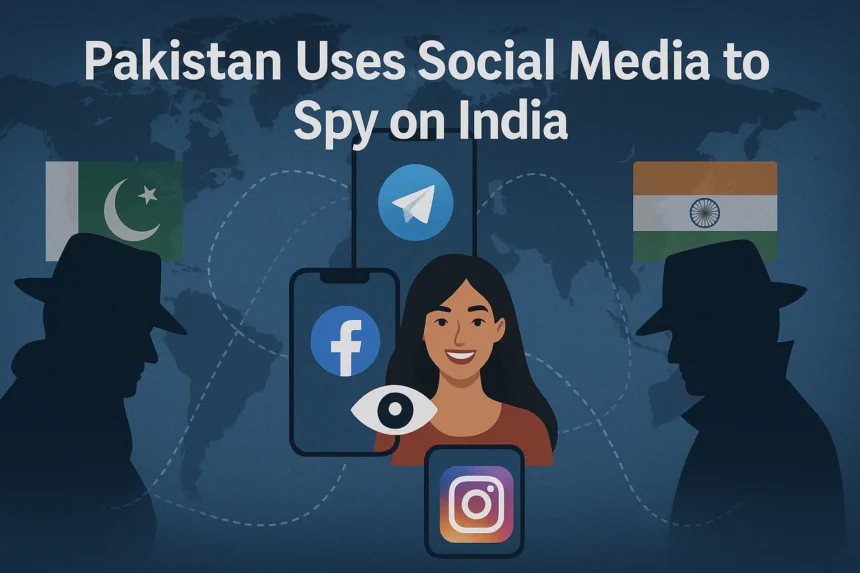The Growing Threat: How Pakistan Uses Social Media to Spy on India
In the age of likes, follows, and reels, espionage has taken a digital twist. No longer confined to secret agents and hidden cameras, spies now scroll through feeds, send friend requests, and slide into DMs. Pakistan’s intelligence agencies, particularly the ISI, have evolved with the times—turning social media into a battlefield where data is the new weapon. And India is a prime target.
This article uncovers the 5 shocking ways Pakistan uses social media to spy on India, with real-world tactics, emotional hooks, and what every Indian citizen should know to stay protected.
1. Honey-Trap Tactics Through Fake Profiles
One of the oldest tricks in the book has gone digital. Pakistani agents create fake profiles, often posing as attractive women, journalists, or defense enthusiasts. They target Indian defense personnel, government employees, and even students preparing for civil or defense exams.
Through flirty chats or professional networking, they extract sensitive information—like troop movements, schedules, and even personal vulnerabilities that can be used later for blackmail or recruitment.
Real Example: Several Indian army jawans have been arrested for leaking information after falling for honey-trap tactics via Facebook and Instagram.
2. Surveillance Through Innocent Apps & Links
Espionage isn’t always flashy. Sometimes, it begins with a harmless-looking app link or a forwarded WhatsApp message. Pakistani-backed operatives use malicious apps disguised as news, fitness, or astrology tools.
Once installed, these apps access contacts, messages, camera, and location data—giving agents a full view into the user’s private life.
Warning: Avoid downloading apps from unknown sources, and don’t click on suspicious social media links, even if they come from friends.
3. Psychological Warfare and Propaganda
Beyond spying, social media is also a weapon of psychological warfare. ISI-run troll farms and fake news networks spread divisive content to stir religious hatred, political polarization, and unrest.
They operate fake pages targeting Indian audiences, using manipulated videos, deepfakes, and misinformation to destabilize public trust in the Indian government and armed forces.
Strategy Tip: Always verify news from official sources and avoid engaging with sensational or unverified content.
4. Grooming and Recruitment of Indian Citizens
In several cases, Indian nationals have been recruited online. Espionage isn’t just about stealing information—it’s also about recruiting informants who blend in locally.
Pakistan-based handlers use Telegram, Instagram, and even LinkedIn to identify vulnerable individuals—those with financial troubles or ideological leanings—and slowly build trust. Once a connection is made, they offer money or ideology-driven incentives to carry out spying missions in exchange for payment.
Case Highlight: Several sleeper cells busted in India were traced back to initial contacts made through social media.
5. Monitoring High-Profile Targets and Military Zones
Using bots, fake accounts, and mass data scraping, Pakistan’s intelligence teams track movement, sentiment, and strategy based on public posts. Soldiers and government officials posting photos from bases or events unknowingly leak visual clues—such as base layouts, uniforms, and troop presence.
Even tourists unknowingly contribute to geo-tagged intelligence, which analysts later examine for patterns and locations.
Safety Tip: Defense personnel and officials should strictly avoid sharing photos or updates from sensitive zones.
The Digital Battlefield Needs Digital Awareness
Pakistan’s use of social media for espionage is not a new phenomenon, but its evolution into a multi-layered digital strategy is alarming. The simplicity of a friend request or a viral meme can mask the complexity of intelligence gathering.
India must evolve too—not just through government-level cybersecurity, but by cultivating a culture of public digital vigilance.
What Is the Government Doing?
Under PM Modi’s leadership, India has launched several initiatives:
- Cyber Surakshit Bharat to train officials in digital hygiene.
- Increased coordination between NIA, IB, RAW, and Army Cyber Units.
- Monitoring of cross-border digital footprints through AI-based tools.
- Awareness campaigns for armed forces on safe social media usage.
How You Can Stay Safe
- Never accept friend requests from unknown people, even if they seem genuine.
- Avoid sharing sensitive work or travel details online.
- Turn off location access unless absolutely necessary.
- Report suspicious content and accounts to cybercrime units.
- Think before you click—always.
Final Thoughts: Awareness Is Our First Line of Defense
Espionage in 2025 doesn’t need a spy in disguise—it just needs a smartphone, a good fake profile, and our unguarded attention. As citizens of India, staying informed and vigilant on social media isn’t just wise—it’s our patriotic duty.
If you found this article helpful, share it with friends and family. Help build a digital India that’s alert, aware, and unbreakable. Follow TN HEADLINES24 for more real, trusted updates.
Most read: https://tnheadlines24.com/travel-vlogger-jyoti-malhotra/
Disclaimer: The information presented in this article is intended solely for educational and informational purposes. TN HEADLINES24 does not assume responsibility for any actions taken by individuals based on the content provided. Readers are strongly advised to exercise discretion and report any suspicious or unlawful activity to the appropriate government or cybersecurity authorities.








